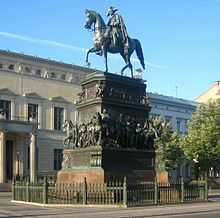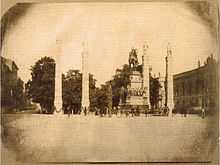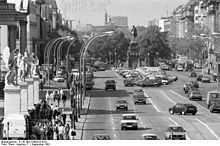Equestrian statue of Frederick the Great


The equestrian statue of Frederick the Great is an outdoor sculpture in cast bronze at the east end of Unter den Linden in Berlin, honouring King Frederick II of Prussia. It was designed in 1839 by Christian Daniel Rauch and unveiled in 1851. It influenced other monuments. After having been enclosed for protection during World War II, the statue and its base were removed by the East Germans in 1950 and re-erected in 1963 at Sanssouci in Potsdam, but returned to Unter den Linden in 1980. After German reunification the monument was moved back to its original location and restored. It is a registered monument of the City of Berlin.
Description and location
The monument is 13.5 metres (44 ft) tall, the mounted statue itself being 5.66 metres (18.6 ft) high on an unusually tall pedestal, 7.84 metres (25.7 ft) with two bands of sculpture above inscriptions: the middle depicts 74 great men of Frederick the Great's time in life size, many in full relief, and the upper section, reliefs of the king's life, with the four cardinal virtues at the corners. The statue itself depicts Frederick in military uniform and an ermine-trimmed cloak, wearing his decorations, and with his characteristic three-cornered hat; he holds the reins in his left hand and in his right has a walking stick.[1]
The statue stands at the east end of Unter den Linden, facing east at the west end of the former Forum Fridericianum (now Bebelplatz) towards the site of the royal palace.[2] It is enclosed by a low wrought-iron fence, which was recreated when the monument was restored and replaced in its original position.[1]
History

Frederick William III commissioned the monument from Christian Daniel Rauch in 1839. It was cast beginning in 1845 by Karl Ludwig Friebel, whom Rauch brought from Lauchhammer for the purpose; changes to the figures on the base extended work to six years,[3] and the monument was unveiled on 31 May 1851.[4] It is one of Rauch's best known works, and influenced other monuments erected in the late 19th and early 20th centuries.[1]
During World War II, the monument was encased in concrete for protection. In May 1950, the East German Magistrat decided to remove it to the park at the palace of Sanssouci in Potsdam. Metal thieves damaged it after the protective casing was removed, and it was dismantled and taken away between 13 and 19 July.[5] After being stored in pieces and at one point almost melted down,[6] by 1962 the monument had been re-erected in the hippodrome at Charlottenhof Palace.
In the 1980s, the East German government changed its politics of memory and especially its position on the Prussian heritage. In 1980 Erich Honecker called Frederick "the Great" in an interview with Robert Maxwell; in the same year, the historian Ingrid Mittenzwei published a relatively positive biography of the king.[7] and the statue was restored and returned to Unter den Linden,[8] approximately 6 metres (20 ft) east of its old position.[6] Western Germany saw a similar return of a more positive view on Prussia with the Berlin exhibition Preußen – Versuch einer Bilanz (Prussia, an attempt at a complete picture).[9] The preparations to celebrate the anniversary of the founding of Berlin in 1987 led to further reconsideration of the Prussian heritage; that year Gisela May performed a song celebrating the statue's return.[10]
After German reunification, the Senate of Berlin had the monument scientifically restored[11] and it was replaced in its original position, with the wrought-iron fence and 19th-century lamp posts recreated. After having paint thrown at it during a protest against the Bundeswehr, it was restored once more in 2006 and given a coating of wax to protect against graffiti.[12]

.jpg)
_4%2C_Aufstellung_in_Potsdam.jpg)

Other statues of Frederick the Great
Johann Gottfried Schadow, who was Rauch's teacher and had received many commissions under the previous king, Frederick William II, had expected to carry out this commission. Already in 1821–22 he had made a lifesize bronze of Frederick the Great with two greyhounds, which is at Sanssouci.[13][14] He also created a marble statue of Frederick for the city of Stettin, now lost, a bronze reproduction of which is now in the grounds outside the New Wing at Charlottenburg Palace.[15]
In 1865 two students of Rauch's, Aloisio Lazzerini and Carlo Baratta, made an approximately half-size copy in marble of Rauch's equestrian statue, which is in the park at Sanssouci.[16]
Another smaller copy of Rauch's statue was made to commemorate Frederick's overnight stay in the Dehlitz section of Lützen before the Battle of Rossbach in 1757, and stood in a park there from 1858 until World War II, when it was moved for safekeeping to Lützen Castle.[17]
References
- ↑ 1.0 1.1 1.2 "Denkmal König Friedrich II. von Preußen", Senatsverwaltung für Stadtentwicklung und Umwelt, Berlin, revised 10 April 2014 (German)
- ↑ Hartwig Schmidt, "Architecture and Urban Planning 1850–1914", Berlin/New York: Like and Unlike: Essays on Architecture and Art from 1870 to the Present, ed. Josef Paul Kleihues and Christina Rathgeber, New York: Rizzoli, 1993, ISBN 9780847816576, pp. 128–44, p. 130.
- ↑ Wolfgang Vomm, Reiterstandbilder des 19. und fruhen 20. Jahrhunderts in Deutschland: zum Verständnis und zur Pflege eines traditionellen herrscherlichen Denkmaltyps im Historismus, dissertation, University of Cologne, 1979, 2 vols. Volume 1 OCLC 256342563, p. 150 (German); the Berlin city monument page misspells Friebel's name as Carl Triebel.
- ↑ Denkmal König Friedrichs des Grossen: enthüllt am 31. Mai 1851, Berlin: Decker, 1851 OCLC 249315081 (German).
- ↑ "Das Denkmal Friedrichs des Großen", in Das Berliner Schloss und sein Untergang. Ein Bildbericht über die Zerstörung Berliner Kulturdenkmäler, ed. Karl Rodemann, Berlin: Tauber, 1951, OCLC 17159620, pp. 23–24 (German).
- ↑ 6.0 6.1 Rudolf Hempel, "Der Ritt in die falsche Richtung", interview with Hans Bentzien, Neues Deutschland, 22 November 1997 (German) (subscription required).
- ↑ Ingrid Mittenzwei, Friedrich II. von Preußen. Eine Biographie. Berlin: Deutscher Verlag der Wissenschaften / Cologne: Pahl–Rugenstein, 1980, ISBN 3-7609-0512-9 (German).
- ↑ T. H. Elkins with B. Hofmeister, Berlin: The Spatial Structure of a Divided City, London/New York: Methuen, 1988, ISBN 9780416922202, p. 11 (digital ed. p. 10).
- ↑ Gottfried Korff (ed.), Preußen – Versuch einer Bilanz, exhibition catalogue, Reinbek bei Hamburg: Rowohlt, 1981. ISBN 3-499-34001-1 (German).
- ↑ Nashenka, "'Der Alte Fritz', Gisela May", Politiek en Cultuur blog, 19 July 2010 (German).
- ↑ "Restaurierung des Bronzestandbildes Friedrich II. wurde fachtechnisch einwandfrei ausgeführt", press release, City of Berlin, 14 June 2001 (German)
- ↑ SAF, "Alter König frisch gereinigt", Berliner Morgenpost, 19 October 2006, archived at the Wayback Machine, 10 March 2007 (German).
- ↑ Georg Sello, Potsdam und Sans-Souci: Forschungen und Quellen zur Geschichte von Burg, Stadt und Park, Breslau: Schottlaender, 1888, OCLC 41962704, p. 133 (German)
- ↑ Gisold Lammel, Kunst im Aufbruch: Malerei, Graphik und Plastik zur Zeit Goethes, Stuttgart: Metzler, 1998, ISBN 9783476015945, p. 502 (German).
- ↑ Friedrich Benninghoven, Helmut Börsch-Supan and Iselin Gundermann, Friedrich der Grosse: Ausstellung des Geheimen Staatsarchivs Preussischer Kulturbesitz anlässlich des 200. Todestages König Friedrichs II. von Preussen, exhibition catalogue, Berlin: Nicolai, 1986, ISBN 9783875841725, p. 337 (German).
- ↑ Georg Hermann, Spaziergang in Potsdam: Nachricht aus einer versunkenen Stadt, Berlin: Christian Blöss, 2014, ISBN 9783934378544, p. 74, n. 44 (German).
- ↑ "Gutspark Dehlen", Ausflüge in Lützen und Umgebung, Town of Lützen, retrieved 28 January 2015 (German).
Further information
- Jutta von Simson. Das Berliner Denkmal für Friedrich den Großen. Die Entwürfe als Spiegelung des preußischen Selbstverständnisses. Frankfurt/Berlin: Ullstein/Propyläen, 1976, ISBN 3-549-06619-8 (German)
- Frank Pieter Hesse and Gesine Sturm (ed.). Ein Denkmal für den König. Das Reiterstandbild für Friedrich II. Unter den Linden in Berlin. Beiträge zur Denkmalpflege in Berlin 17. Schelzky & Jeep, 2001, ISBN 978-3-89541-158-8 (German/English picture book)
- Wieland Giebel (ed.). Das Reiterdenkmal Friedrichs des Großen. Berlin: Story, 2007, ISBN 978-3-929829-69-3 (German)
- Majestät reiten wieder, video on restoration completed in 2001, Mefisto Video GmbH (Windows Media Player) (German)
External links
-
 Media related to Equestrian statue of Frederick the Great at Wikimedia Commons
Media related to Equestrian statue of Frederick the Great at Wikimedia Commons -
 Media related to Lazzerini and Baratta's marble replica at Sanssouci at Wikimedia Commons
Media related to Lazzerini and Baratta's marble replica at Sanssouci at Wikimedia Commons
Coordinates: 52°31′02″N 13°23′34″E / 52.51722°N 13.39278°E